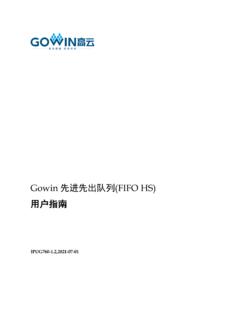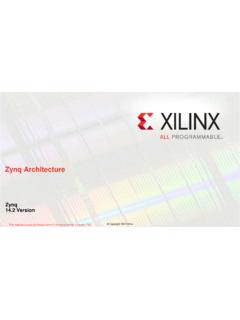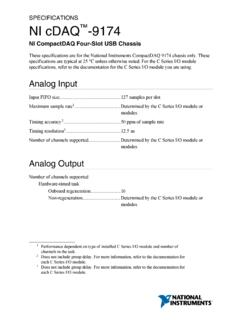Transcription of FIFO Generator v13 - Xilinx
1 fifo Generator IP Product GuideVivado Design SuitePG057 April 5, 2017 fifo Generator April 5, 2017 Table of ContentsIP FactsChapter 1: OverviewNative Interface FIFOs .. 5 AXI Interface FIFOs.. 6 Feature Summary.. 8 Applications .. 62 Licensing and Ordering Information .. 65 Chapter 2: Product SpecificationPerformance .. 66 Resource Utilization .. 77 Port Descriptions .. 77 Chapter 3: Designing with the CoreGeneral Design Guidelines .. 93 Initializing the fifo Generator .. 95 fifo Usage and Control .. 95 Clocking.. 121 Resets .. 126 Actual fifo Depth .. 134 Latency .. 136 Special Design Considerations .. 148 Chapter 4: Design Flow StepsCustomizing and Generating the Native Core .. 153 Customizing and Generating the AXI Core .. 170 Constraining the Core .. 182 Simulation .. 182 Synthesis and Implementation.
2 184 Chapter 5: Detailed Example DesignImplementing the Example Design .. 185 Send FeedbackFIFO Generator April 5, 2017 Simulating the Example Design.. 186 Chapter 6: Test BenchTest Bench Functionality .. 187 Customizing the Demonstration Test Bench .. 188 Messages and Warnings .. 189 Appendix A: Verification, Compliance, and InteroperabilitySimulation .. 190 Appendix B: DebuggingFinding Help on .. 191 Debug Tools .. 192 Simulation Debug.. 193 Hardware Debug .. 193 Interface Debug .. 193 Appendix C: Migrating and UpgradingMigrating to the Vivado Design Suite .. 195 Upgrading in the Vivado Design Suite .. 195 Appendix D: dout Reset Value TimingAppendix E: fifo Generator FilesAppendix F: Supplemental InformationAppendix G: Additional Resources and Legal NoticesXilinx Resources .. 215 References.
3 215 Revision History .. 216 Please Read: Important Legal Notices .. 218 Send FeedbackFIFO Generator April 5, 2017 Product SpecificationIntroductionThe Xilinx LogiCORE IP fifo Generator core is a fully verified first -in first -out ( fifo ) memory queue for applications requiring in-order storage and retrieval. The core provides an optimized solution for all fifo configurations and delivers maximum performance (up to 500 MHz) while utilizing minimum resources. Delivered through the Vivado Design Suite, you can customize the width, depth, status flags, memory type, and the write/read port aspect fifo Generator core supports Native interface FIFOs, AXI Memory Mapped interface FIFOs and AXI4-Stream interface FIFOs. Native interface fifo cores are optimized for buffering, data width conversion and clock domain decoupling applications, providing ordered storage and Memory Mapped and AXI4-Stream interface FIFOs are derived from the Native interface fifo .
4 Three AXI Memory Mapped interface styles are available: AXI4, AXI3 and more details on the features of each interface, see Feature Summary in Chapter FactsLogiCORE IP Facts TableCore SpecificsSupported Device Family(1)UltraScale+ Families, UltraScale Architecture, Zynq -7000, 7 SeriesSupported User InterfacesNative, AXI4-Stream, AXI4, AXI3, AXI4-LiteResourcesPerformance and Resource Utilization web pageProvided with CoreDesign FilesEncrypted RTLE xample DesignVHDLTest BenchVHDLC onstraints FileXDCS imulation ModelVerilog Behavioral(2)Supported S/W DriverN/ATe s t e d D e s i g n F l o w s(4)Design EntryVivado Design SuiteSimulation(3)For other supported simulators, see the XilinxDesign Tools: Release Notes SynthesisSupportProvided by Xilinx at the Xilinx Support web pageNotes: 1. For a complete listing of supported devices, see the Vivado IP Behavioral model does not model synchronization delay.
5 See Simulation in Chapter 4 for The fifo Generator core supports the UniSim simulation For the supported versions of the tools, see the Xilinx Design Tools: Release Notes FeedbackFIFO Generator April 5, 2017 Chapter 1 OverviewThe fifo Generator core is a fully verified first -in first -out memory queue for use in any application requiring ordered storage and retrieval, enabling high-performance and area-optimized designs. The core provides an optimized solution for all fifo configurations and delivers maximum performance (up to 500 MHz) while using minimum resources. This core supports Native interface FIFOs, AXI Memory Mapped interface FIFOs and AXI4-Stream interface FIFOs. AXI Memory Mapped and AXI4-Stream interface FIFOs are derived from the Native interface fifo . Three AXI Memory Mapped interface styles are available: AXI4, AXI3 and core can be customized using the Vivado IP customizers in the IP catalog as a complete solution with control logic already implemented, including management of the read and write pointers and the generation of status :The Memory Mapped interface fifo and AXI4-Stream interface fifo are referred as "AXI fifo " throughout this Interface FIFOsThe Native interface fifo can be customized to utilize block RAM, distributed RAM or built-in fifo resources available in some FPGA families to create high-performance, area-optimized FPGA mode and first Word Fall Through are the two operating modes available for Native interface FeedbackFIFO Generator April 5, 2017 Chapter 1.
6 OverviewAXI Interface FIFOsAXI interface FIFOs are derived from the Native interface fifo , as shown in Figure 1-2. Three AXI memory mapped interface styles are available: AXI4, AXI3 and AXI4-Lite. In addition to applications supported by the Native interface fifo , AXI FIFOs can also be used in AXI System Bus and Point-to-Point high speed interface FIFOs do not support built-in fifo and Shift Register fifo the AXI FIFOs in the same applications supported by the Native Interface fifo when you need to connect to other AXI functions. AXI FIFOs can be integrated into a system by using the IP integrator. See the Vivado Design Suite User Guide: Designing IP Subsystems using IP Integrator (UG994) [Ref 5] for more Target - Figure 1-1 Figure 1-1:Native Interface FIFOs Signal Diagramdout[m:0]emptyrd_enWrite Clock DomainRead Clock Domainfullwr_endin[n:0]almost_fullProg_f ullalmost_emptyprog_emptyvalidunderflowp rog_empty_thresh_assertsbiterrdbiterrwr_ ackoverflowwr_data_count[p:0]prog_full_t hresh_assertprog_full_thresh_negateprog_ full_threshinjectsbiterrinjectdbiterrwr_ rstrstrd_rstOPTIONALMANDATORYOPTIONAL SIDEBANDwr_clkrd_clkRead AgentWrite Agentrd_data_count[q:0]prog_empty_thresh _negateprog_empty_threshSend FeedbackFIFO Generator April 5, 2017 Chapter 1:OverviewThe AXI interface protocol uses a two-way valid and ready handshake mechanism.
7 The information source uses the valid signal to show when valid data or control information is available on the channel. The information destination uses the ready signal to show when it can accept the data. Figure 1-3 shows an example timing diagram for write and read operations to the AXI4-Stream fifo , and Figure 1-4 shows an example timing diagram for write and read operations to the AXI memory mapped interface Target - Figure 1-2 Figure 1-2:AXI fifo DerivationX-Ref Target - Figure 1-3 Figure 1-3:AXI4-Stream fifo Timing Diagramfullrd_clkrd_enwr_enwr_clkrstdin[ n:0]dout[n:0]*VALID*ready*validempty*dat a*strobe*last*user*id---*data*strobe*las t*user*id---s_aclks_aresetnm_aclkAXI4 SLAVEAXI4 MASTERWRITE CLOCKDOMAINREAD CLOCKDOMAINwr_data_count[P:0]overflowinj ectsbiterrprog_full_threshinjectdbiterrr d_data_count[Q:0]underflowsbiterrprog_em pty_threshprog_fullprog_emptydbiterrMAND ATORYOPTIONAL SIDEBANDAXI4 MASTERAXI4 SLAVEX12629*ready*validSend FeedbackFIFO Generator April 5, 2017 Chapter 1.
8 OverviewIn Figure 1-3 and Figure 1-4, the information source generates the valid signal to indicate when the data is available. The destination generates the ready signal to indicate that it can accept the data, and transfer occurs only when both the valid and ready signals are AXI FIFOs are derived from Native interface FIFOs, much of the behavior is common between them. The ready signal is generated based on availability of space in the fifo and is held high to allow writes to the fifo . The ready signal is pulled Low only when there is no space in the fifo left to perform additional writes. The valid signal is generated based on availability of data in the fifo and is held High to allow reads to be performed from the fifo . The valid signal is pulled Low only when there is no data available to be read from the fifo . The information signals are mapped to the din and dout bus of Native interface FIFOs.
9 The width of the AXI fifo is determined by concatenating all of the information signals of the AXI interface. The information signals include all AXI signals except for the valid and ready handshake FIFOs operate only in first -Word Fall-Through mode. The first -Word Fall-Through (FWFT) feature provides the ability to look ahead to the next word available from the fifo without issuing a read operation. When data is available in the fifo , the first word falls through the fifo and appears automatically on the output data SummaryCommon Features Supports Native, AXI4-Stream, AXI4, AXI3 and AXI4-Lite interfaces fifo depths up to 131,072 wordsX-Ref Target - Figure 1-4 Figure 1-4:AXI Memory Mapped Interface fifo Timing DiagramSend FeedbackFIFO Generator April 5, 2017 Chapter 1:Overview Independent or common clock domains VHDL example design and demonstration test bench demonstrating the IP core design flow, including how to instantiate and simulate it Fully configurable using the Xilinx Vivado IP Catalog customizerNative fifo Specific Features fifo data widths from 1 to 1024 bits Symmetric or Non-symmetric aspect ratios (read-to-write port ratios ranging from 1:8 to 8.)
10 1) Synchronous or asynchronous reset option Selectable memory type (block RAM, distributed RAM, shift register, or built-in fifo ) Option to operate in Standard or first -Word Fall-Through modes (FWFT) Full and Empty status flags, and Almost Full and Almost Empty flags for indicating one-word-left Programmable Full and Empty status flags, set by user-defined constant(s) or dedicated input port(s) Configurable handshake signals Hamming Error Injection and Correction Checking (ECC) support for block RAM and Built-in fifo configurations Soft ECC support for block RAM FIFOs (upto 64-bit data widths) Embedded register option for block RAM and built-in fifo configurations Dynamic Power Gating and ECC Pipeline Register support for UltraScale Architecture Built-in fifo ConfigurationsAXI fifo Features fifo data widths: AXI Stream: 1 to 4096 bits AXI4/AXI3: 32, 1024 (multiples of 2) bits AXI4-Lite: 32, 64 bits Supports AXI memory mapped and AXI4-Stream interface protocols - AXI4, AXI3, AXI4-Stream, and AXI4-Lite Symmetric aspect ratios Asynchronous active-Low reset Selectable configuration type ( fifo , Register Slice, or Pass Through Wire)Send FeedbackFIFO Generator April 5, 2017 Chapter 1.
















